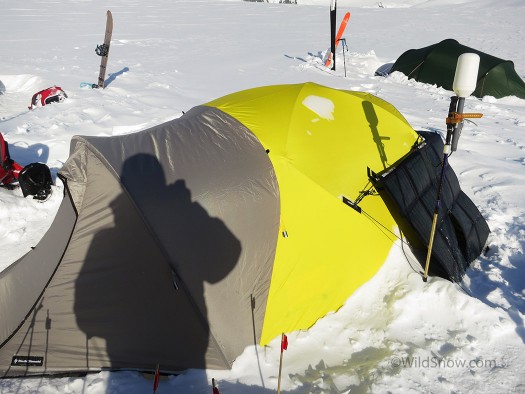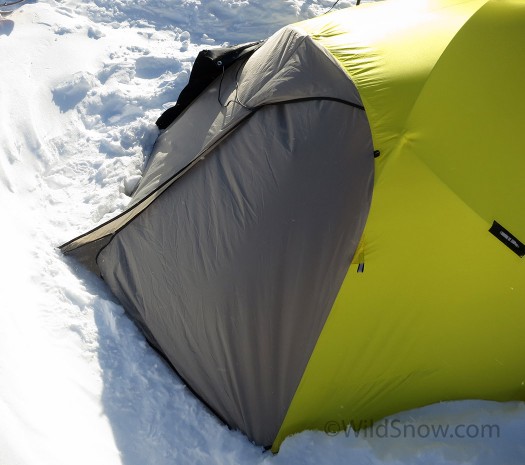The Black Diamond Bombshelter tent is aptly named. It’s a burly single wall dome tent.
I’ve never had a solid, strong mountaineering tent. For years I’ve used the lightweight and survivable combo of a bivy sack and a Megamid, or borrowed tents from friends. Also, being mostly a weekend warrior, I rarely spend that many consecutive nights in a tent. However, I knew that on my trip to Alaska this spring I’d need a good, strong tent. I started looking for something that would hold up to potentially heinous Alaskan weather, while still being versatile enough to use for other trips.
I’ve always had the opinion that double wall tents were the only way to cut out excessive condensation while still being sufficiently weatherproof. Unfortunately most double wall mountain tents are heavy, making their single wall cousins more attractive. In my experience, single wall tents seem to work for short periods, but don’t breathe well enough to keep gear dry for a long period. Most waterproof breathable fabric is designed for use in clothing, and utilizes the temperature gradient between the warm body and the cold outdoors to transport moisture to the outside. Unfortunately that idea doesn’t work very well in tents, since the difference in interior/exterior temperature is frequently small, or may be nonexistent. Moisture tends to collect as condensation, and then drips or runs down the walls before it can be transported outside.
Nonetheless, after doing some research I decided to try out one of Black Diamond’s Bibler tents. The Bibler series is single wall, but uses a heavyweight ToddTex fabric that is designed to be very waterproof and breathable. The fabric is a little strange; it is some sort of traditional waterproof breathable laminate, but has a “fuzzy” material laminated on the inside that collects moisture and helps transport it to the outside. The fuzzy stuff supposedly helps it stay a bit warmer as well (another advantage of double wall tents).

The Bombshelter tent with the integrated front vestibule. Also notice our rad satellite phone blogging setup.
I picked up a Bombshelter just in time to test it out in Alaska last March. Our plans for basecamp were luxurious. Coop and I shared the four-man tent, giving us plenty of space for all our gear. We spent about 10 nights in the tent in all sorts of weather. I’ve used the tent on a few trips since then. We encountered a big variety of weather, everything from hot, sunny days, to windy storms that dumped snow, although thankfully no rain.
I was expecting to deal with tent wall condensation during the trip, but surprisingly it wasn’t an issue. It formed only on one or two occasions, and never in large amounts. Impressive! In addition to the breathable material, the Bombshelter has ample venting with two vestibules at either end. We kept the door open most nights, although we sealed it up during cold and stormy nocturnal interludes.
The Bombshelter, like all Bibler tents, sets up from the inside, with the poles simply pressing against the tent fabric. That has both advantages and disadvantages. It allows you to get out of the weather while setting it up. On a recent trip up to mosquito-infested Mt. Adams, it was great to be able to escape the little bloodsuckers, and set up the tent in peace. It also makes the tent simpler, and lighter weight. On the other hand, I found it a bit more difficult to get the poles in place, compared to just sliding them through sleeves. Also, there’s a very big risk of poking the pole through the tent, as you’re sliding it in. I almost did this at least once.
Another advantage of the pole system, is that once the Bombshelter is set up, the fabric is as tight as a drum. I’ve sat out some quite windy storms and the tent barely flaps at all — a big help if you’re trying to catch some shuteye during a big storm. Unfortunately the tautness also makes it a bit easier to rip the tent; I managed to put a little gash in the side with my shovel at one point. Luckily it was tiny and easily fixed with seam sealer.
The Bombshelter is advertised as a four man tent, however like many mountaineering tents, it’s made as small as possible so it would be a tight squeeze for four. It would be quite comfortable for three, and for two (like we had) it’s spacious. The tent also has two integrated vestibules. The front has it’s own pole, and is large enough for storing lots of gear or cooking. The rear vestibule is much smaller and only useful for storing a few small things, and as a cover if you want to leave the back door open.
The Bombshelter proved to be a perfect choice for an Alaskan basecamp tent. In addition to being strong and spacious, it’s light enough to have been useful for a few other trips this winter and spring as well. Of course, a double wall tent is warmer and even better at dealing with condensation, but with most you pay a heavy weight penalty. Bibler tents have a well-deserved reputation for being burly, lightweight, and well thought out. The Bombshelter certainly lives up to the rep.
Louie Dawson earned his Bachelor Degree in Industrial Design from Western Washington University in 2014. When he’s not skiing Mount Baker or somewhere equally as snowy, he’s thinking about new products to make ski mountaineering more fun and safe.



